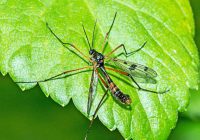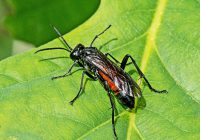Dr Phil Smith’s Wildlife Notes
May 2020
The spring drought continued and intensified during May, which was the sunniest and driest in England since records began in 1929. By the end of the month, water companies were requesting cutbacks in the rate of water use, while some TV weather presenters were reluctantly admitting that “We might need some rain.” Meanwhile, vegetation on the dunes and road verges dried to a crisp, fires inevitably breaking out along the coast and on moorland. Fortunately, many of our dune wetlands, recharged by a wet winter, still had surface water, though the water-table at my Devil’s Hole measuring point fell 21 cm during May. This meant a rescue operation was needed to move large numbers of Natterjack tadpoles into deeper water. Mike Brown of North Merseyside Amphibian & Reptile Group kindly helped with this licensed work at short notice. One of the problems at the Devil’s Hole and elsewhere is owners allowing their dogs to play in the slacks and scrapes. This can strand Natterjack tadpoles which cluster in the warmest water at the edge. When asked politely, most dog-walkers comply but this is not always the case, as on 28th, when a prolonged stream of foul language and aggressive insults followed a similar request.
The effects of the drought were evident at Haskayne Cutting Nature Reserve where Patricia Lockwood and I did our annual count of marsh-orchids. Numbers of Southern and Northern Marsh-orchids declined 40% from last year’s 4400 to 2600, many of the plants being small and obviously suppressed by the dry conditions. In contrast, the beautiful flowers of Water Avens seemed unaffected as they benefited from the shade of a willow bush. Haskayne Cutting also produced some interesting insects, the star being a hoverfly I have wanted to see for some time. The bright-orange “mini-tiger” Parhelophilus is local in our region, being associated with Bulrush in wetlands.
In general, insects, seem to have done well during the drought, though it is likely to impact the grass-feeding species later on. Many species appeared earlier than usual. For example, my first Banded Demoiselle on 14th at Alt Bridge, Downholland Brook, was about a fortnight early. This excellent locality, five minutes from my home, also produced several Large Red Damselflies, recorded for the first time here last year. During my visits, I was serenaded continuously by a Reed Warbler.
Several birds mimic other species and I was greatly entertained by a Sedge Warbler at Sands Lake incorporating phrases from Oystercatcher and Song Thrush into its chattering song. I was pleased to find Bog-bean in flower on the lake-side. A large patch of yellow-flowered Alexanders attracted lots of nectaring insects, including the wetland hoverfly Riponnensia splendens. Also there was a new species to me, the Phantom Crane-fly Ptychoptera contaminata with its spotty wings. Although it resembles a crane-fly or “daddy long-legs” it belongs to a different family and is found in damp, shady places.
The south-facing woodland edge at Ravenmeols is also good for insects, a special find on 3rd being four Spring Heath Robberflies. In the April notes, I highlighted this nationally scarce insect as a Sefton Coast speciality. The same area produced my first Small Heath butterfly of the year, a mating pair of Common Blues and the strange sawfly Macrophya annulata. This mimics red-and-black spider-hunting wasps so effectively that, when I examined the photo, I thought it was one of them. However, the wasp and bee expert, Ben Hargreaves, knew otherwise.
Late in the month, I travelled a little further to the Leeds-Liverpool Canal at Aintree. In the hope of finding the Red-eyed Damselfly at one of its few haunts in the Northwest. Sections of the canal were drained by a major leak last year and there were concerns this might have affected its fauna. It was hard graft but I eventually found my quarry, counting 10 Red-eyes, including three pairs, on water-lily leaves.
There were some spectacular finds by others during the month. Reports of Hairy Dragonfly at Lunt Meadows Nature Reserve were finally confirmed on 25th when Phil Boardman took an excellent photograph of a male. This was the first for Lancashire and North Merseyside of a dragonfly that is slowly expanding its range. Also new to the region was Pete Kinsella’s Pine Callicera,a rare hoverfly that used to be confined to Caledonian pine forests in the Scottish Highlands. From 2011, it began to turn up in pine plantations in England. On 20th, Pete decided to check Ravenmeols for the hoverfly and, after only an hour of searching, spotted two males high up on a pine trunk. He suggests that further searches in the Sefton pinewoods will surely produce more sightings of this charismatic insect. Finally, Gary Hedges of the Tanyptera Project at World Museum Liverpool went to Freshfield to hunt for a very rare, scarab beetle, the tiny Red Dune Crawler Rhysothorax rufa. After sieving large amounts of sand in the frontal dunes, he was rewarded by a single dead specimen of the target beetle. It has only ever been found at five British localities, this being the first for 14 years of a species that is listed as “endangered” in the UK and has drastically declined from being described as “abundant” in the late 19th and early 20th centuries.
As I write these notes, a Song Thrush is singing full blast in the garden. Perhaps it is one that I fed during the winter. This month, water rather than food has been crucial for garden birds. From my lounge chair, I have watched Starlings and House Sparrows jostling to drink or bathe in a bowl that sometimes needed topping up several times a day. Surely June can’t be as dry as this!





